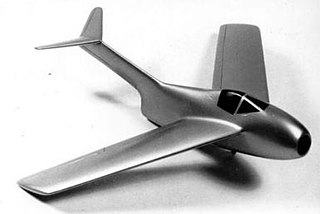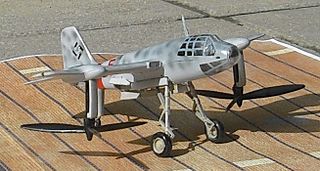Related Research Articles

The Focke-Wulf Fw 190 Würger was a German single-seat, single-engine fighter aircraft designed by Kurt Tank in the late 1930s and widely used during World War II. Along with its well-known counterpart, the Messerschmitt Bf 109, the Fw 190 became the backbone of the Luftwaffe's Jagdwaffe. The twin-row BMW 801 radial engine that powered most operational versions enabled the Fw 190 to lift larger loads than the Bf 109, allowing its use as a day fighter, fighter-bomber, ground-attack aircraft and, to a lesser degree, night fighter.

The Focke-Wulf Fw 61 is often considered the first practical, functional helicopter, first flown in 1936. It was also known as the Fa 61, as Focke began a new company—Focke-Achgelis—in 1937.

The Focke-Wulf Fw 187 Falke ("Falcon") was a German aircraft developed in the late 1930s. It was conceived by Kurt Tank as a twin-engine, high-performance fighter, but the Luftwaffe saw no role for the design, perceiving it as intermediate between the Messerschmitt Bf 109 and Bf 110. Later prototypes were adapted to two-seats to compete with the Bf 110 in the Zerstörer role, but only nine aircraft were built in total.

The Focke-Wulf Fw 189 Uhu is a German twin-engine, twin-boom, three-seat tactical reconnaissance and army cooperation aircraft. It first flew in 1938, entered service in 1940 and was produced until mid-1944.

The Messerschmitt Me 328 was originally designed as a parasite aircraft to protect Luftwaffe bomber formations during World War II. During its protracted development, a wide variety of other roles were suggested for it. Late in the war, the design was resurrected for consideration as a Selbstopfer aircraft, but was judged unsuitable even for this purpose. The tiny fighter was to have been propelled by pulsejets, but the unsuitability of these engines doomed the Me 328 from the start.
Argus Motoren was a German manufacturing firm known for their series of small inverted-V engines and the Argus As 014 pulsejet for the V-1 flying bomb.

The Messerschmitt Me 309 was a prototype German fighter, designed in the early years of World War II to replace the Bf 109. Although it had many advanced features, the Me 309's performance left much to be desired and it had so many problems that the project was cancelled with only four prototypes built. The Me 309 was one of two failed Messerschmitt projects intended to replace the aging Bf 109, the other being the Me 209 of 1943.

The Focke-Wulf Ta 183 Huckebein was a design for a jet-powered fighter aircraft intended as the successor to the Messerschmitt Me 262 and other day fighters in Luftwaffe service during World War II. It was developed only to the extent of wind tunnel models when the war ended, but the basic design was further developed postwar in Argentina as the FMA IAe 33 Pulqui II. The name Huckebein is a reference to a trouble-making raven from an illustrated story in 1867 by Wilhelm Busch.

The Focke-Wulf Fw 56 Stösser was a single-engine, parasol monoplane advanced trainer, built in the 1930s in Germany.
The Focke-Wulf Project I was a design study for a jet fighter, to be built in Germany during World War II. In 1942, the Reichsluftministerium (RLM) asked Professor Kurt Tank of the Focke-Wulf factory to investigate the possibility of a single-engine jet fighter. He was given the development plans of the BMW 003, Jumo 004 and Heinkel HeS 011 engines. Late in 1942 the Project Office, led by Ludwig Mittelhuber, began to work on a series of fighter projects, to be powered by one of these new turbojet units.
The Focke-Wulf Project II was a design study for a single-seat jet fighter, carried out in Germany during World War II.

The Focke-Wulf Project VII Flitzer was a jet fighter under development in Germany at the end of World War II.
Focke-Wulf Project VIII was a design study for a turboprop-powered fighter-bomber, undertaken in Germany during World War II.
The Focke-Wulf Fw 43 Falke - known internally to Focke-Wulf as the A 43 - was a light utility aircraft developed in Germany in 1932. The last project undertaken by the company under the technical direction of Henrich Focke, it was a high-wing strut-braced monoplane of conventional design, with fixed tailwheel undercarriage. The pilot and two passengers sat in a fully enclosed cabin. Only a single example was built.
The Focke-Wulf Fw 47 Höhengeier, known internally to Focke-Wulf as the A 47, was a meteorological aircraft developed in Germany in 1931. It was a parasol-wing monoplane of largely conventional design, unusual only in the expansiveness of its wing area. Tested first by the Reichsverband der Deutschen Luftfahrtindustrie, and then the weather station at Hamburg, the type was ordered into production to equip ten major weather stations around Germany.

The Focke-Achgelis Fa 269 was a tiltrotor VTOL aircraft project designed by Henrich Focke.

The Blohm & Voss P 194 was a German design for a mixed-power Stuka or ground-attack aircraft and tactical bomber, during World War II.

The Heinkel He P.1079 was a projected German V-tail all weather jet fighter designed by Heinkel Flugzeugwerke in the closing stages of World War II. The aircraft was only a design; it was not produced.

The Arado Ar 77 was a German twin-engined monoplane, designed as an advanced training aircraft from 1934.
References
- Lens, K.; H. J. Nowarra (1964). Die Deutschen Flugzeuge. Munich: J F Lehmans Verlag.
- Masters, David (1982). German Jet Genesis. London: Jane's Publishing.
- Nowarra, Heinz (1983). Die deutsche Luftrüstung 1933–1945. Bonn: Bernard and Graefe. pp. Teil 2, p.114.
- Smith, J. R. (1973). Focke-Wulf: An Aircraft Album. London: Ian Allan.
- Smith, J. R.; A. Kay (1972). German Aircraft of the Second World War. London: Putnam.
- Wagner, Wolfgang (1980). Kurt Tank: Konstruckteur und Test Pilot bei Focke-Wulf. Munich: Bernard and Graefe.